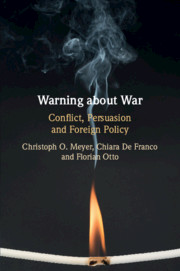Book contents
- Warning about War
- Warning about War
- Copyright page
- Contents
- Figures
- Tables
- Acknowledgements
- Chapter 1 Conflict Warnings as Persuasion Attempts
- Chapter 2 A Theory of Conflict Warning as Persuasion in Foreign Policy
- Chapter 3 Inside-Up Warnings within States and International Organisations
- Chapter 4 Outside-In Warnings
- Chapter 5 Outside-In Warnings
- Chapter 6 (Mis-)identifying Warnings and the Problem of Hindsight Bias
- Chapter 7 What Makes Individual Officials Persuasive Warners?
- Chapter 8 Explaining Differences in Persuasiveness
- Chapter 9 Warning within EU Institutions and the Ukrainian-Russian Conflict of 2013–2014
- Chapter 10 When Are Warnings Heeded and What Can Warners Do?
- References
- Index
Chapter 10 - When Are Warnings Heeded and What Can Warners Do?
Published online by Cambridge University Press: 23 August 2019
- Warning about War
- Warning about War
- Copyright page
- Contents
- Figures
- Tables
- Acknowledgements
- Chapter 1 Conflict Warnings as Persuasion Attempts
- Chapter 2 A Theory of Conflict Warning as Persuasion in Foreign Policy
- Chapter 3 Inside-Up Warnings within States and International Organisations
- Chapter 4 Outside-In Warnings
- Chapter 5 Outside-In Warnings
- Chapter 6 (Mis-)identifying Warnings and the Problem of Hindsight Bias
- Chapter 7 What Makes Individual Officials Persuasive Warners?
- Chapter 8 Explaining Differences in Persuasiveness
- Chapter 9 Warning within EU Institutions and the Ukrainian-Russian Conflict of 2013–2014
- Chapter 10 When Are Warnings Heeded and What Can Warners Do?
- References
- Index
Summary
The concluding chapter draws on findings from preceding chapters to return to the original question: What makes warnings about conflicts in foreign countries persuasive? It argues that existing research in conflict prevention has tended to over-count warnings and exaggerate their persuasiveness. Most analytical products dealing with the political situation in foreign countries did not clearly announce themselves as warnings, or their warning content was highly hedged, opaque or hidden within conventional reporting or current intelligence. At the same time, inside-up warnings are influenced by outside-in warnings and the broader information environment created by media and NGOs. Six ‘first order’ factors are most significant to explain the findings as they shape persuasion paths: diagnostic difficulties specific to each case, the level of political equity at stake in a given country, individual capacities and the credibility of inside-up warners, the degree of engagement of a small group of highly capable and credible outside-in warners, the degree of agenda competition and, finally, the role of pre-existing policy biases. The chapter examines what these findings mean for prospective warners, which questions they should ask themselves, and how they can increase the chances of their warnings being listened to and, perhaps, even heeded.
- Type
- Chapter
- Information
- Warning about WarConflict, Persuasion and Foreign Policy, pp. 265 - 283Publisher: Cambridge University PressPrint publication year: 2019

